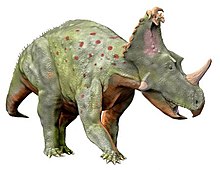Coronosaurus brinkmani
|
Coronosaurus Temporal range: Late Cretaceous, 77 Ma |
|
|---|---|
 |
|
| Restoration | |
| Scientific classification | |
| Kingdom: | Animalia |
| Phylum: | Chordata |
| Class: | Reptilia |
| Clade: | Dinosauria |
| Order: | †Ornithischia |
| Family: | †Ceratopsidae |
| Clade: | †Centrosaurini |
| Genus: |
†Coronosaurus Ryan, Evans & Shepherd, 2012 |
| Type species | |
|
†Coronosaurus brinkmani (Ryan & Russell, 2005) |
|
| Synonyms | |
|
Centrosaurus brinkmani |
|
Centrosaurus brinkmani
Ryan & Russell, 2005
Coronosaurus is a genus of centrosaurine ceratopsian dinosaurs which contains one known species, Coronosaurus brinkmani, originally classified in the genus Centrosaurus. Its remains were discovered in the Oldman Formation of Alberta, Canada, dated to the Late Cretaceous (middle Campanian stage).
Coronosaurus is a medium-sized centrosaurine ceratopsid. Gregory S. Paul in 2010 estimated its body length at five meters, its weight at two tonnes. It had as an adult inflated supraorbital horncores — the "brow horns" above the eye sockets — but not elongated as in Zuniceratops, chasmosaurines, and more basal centrosaurines (like Albertaceratops and Diabloceratops), that project laterally (to the sides) over the orbit. However, as a sub-adult its postorbital horncores are pyramidal in shape with a slight lateral inflection of the distal, upper, one half. Coronosaurus is unique among ceratopsians in possessing on the rear frill of the skull a number of accessory epiparietal ossifications on its posterior parietal bar that fuse to the posterior and dorsal frill surfaces. They develop through ontogeny, the growth of the individual, as short spines that may fuse along their adjacent margins into larger, irregular bone masses. They are located close to the midline of the frill in a closely packed bunch above the base of the first epiparietal (P1), the bone spur that at each side growths downwards over the large opening in each frill half. They contribute to the substance of P1 and, through fusion, form a composite epiparietal, that is equivalent to the second epiparietal (P2) normally formed in a more lateral position. The P1 bases can thus be considered the growth positions of the second epiparietals, the P2 loci. Coronosaurus has also a uniquely shaped P3 epiparietal. It is variably developed as a short tongue-like hook or tapered spike that is oriented dorsolaterally, following the curve of the frill. Otherwise, as far as is known Coronosaurus resembles Centrosaurus and Styracosaurus in its morphology. For example, the nasal of Coronosaurus closely resembles that of Centrosaurus apertus in its unfused juvenile or subadult and fused adult forms and appears to have undergone a similar ontogenetic changes. Its erect, laterally compressed nasal horn core has a blunt tip that is formed from the fusion of the opposing nasals. It sits over the posterior portion of the external nares, as it does in all centrosaurines. All juvenile and most adult specimens have gently recurved anterior and posterior margins resulting in most horns having an apex that is oriented at least slightly caudally (backwards).
...
Wikipedia
